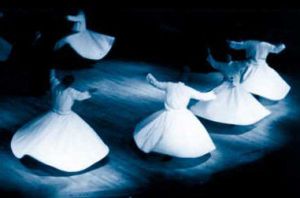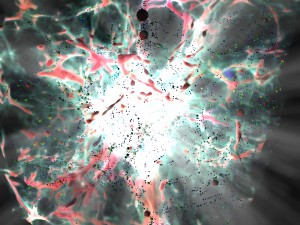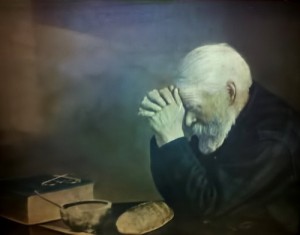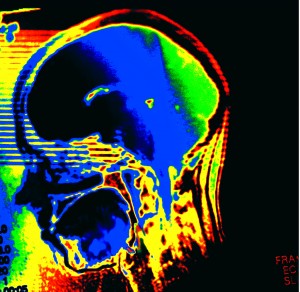 the night is very dark — no moon — no clouds ……. stars are blazingly bright ……. billions of stars in the milky way are so clear …….. the vastness is incomprehensible ….…… I feel so small ……… am I part of this universe? ………. now, fear …….. in an instant, I am part of this one great universe …………. now, calm, bliss ……..….. suddenly, I am back in my yard looking up at the stars
the night is very dark — no moon — no clouds ……. stars are blazingly bright ……. billions of stars in the milky way are so clear …….. the vastness is incomprehensible ….…… I feel so small ……… am I part of this universe? ………. now, fear …….. in an instant, I am part of this one great universe …………. now, calm, bliss ……..….. suddenly, I am back in my yard looking up at the stars
A sudden dramatic sense of “oneness” with the universe is often part of spiritual or religious experience. The suddenness of these experiences makes it difficult to study and capture on MRI. One study that tried, asked religious subjects to remember spiritual experiences. They couldn’t duplicate these experiences on demand.
In the last several posts, scientific understanding of a variety of extraordinary experiences has been discussed. Experimentally, body consciousness was separated from the self-identity and produced out of body experiences, OBEs. In research, psychedelics appeared to trigger religious, or transcendent experiences that were life changing in some. Brain imaging of those taking psychedelics showed a dramatic decrease in the default mode network, the brain region most closely associated with a sense of self, the sense of “I”.
 There are many specific circumstances that seem to stimulate spiritual experiences. Precipitants to religious experience include awe inspiring natural scenes, meditation, prayer, music, dance, extended exercise or exertion, extreme physical conditions, fasting, medical illness, near death experiences, psychedelics, and brain injuries including stroke and temporal lobe epilepsy.
There are many specific circumstances that seem to stimulate spiritual experiences. Precipitants to religious experience include awe inspiring natural scenes, meditation, prayer, music, dance, extended exercise or exertion, extreme physical conditions, fasting, medical illness, near death experiences, psychedelics, and brain injuries including stroke and temporal lobe epilepsy.
Although difficult to study, this post will discuss what science knows about spiritual and religious experiences.
Attempts to Define Religious and Spiritual Experience
Some believe that the only way to define a real spiritual experience is by observing the effect that the experience has. For example, does the transcendent experience lead to being a better person and more compassionate?
William James attempted a definition:
 The experience is sudden, temporary and outside of the normal experience of space and time. The experiencer soon returns to normal. It is not under any control.
The experience is sudden, temporary and outside of the normal experience of space and time. The experiencer soon returns to normal. It is not under any control.
It can’t be put into words.
Something important has occurred that increased knowledge or insight.
The subjective experience happens to an individual not a group. Although group prayer and meditation services precipitate them, the experience is private.
Ralph Hood in 1975 developed a useful research scale, called the Mysticism or M scale, which has been widely used in studies. Additional characteristics from the M scale include:
A loss of self while consciousness is maintained, commonly experienced as absorption into something greater
Perception of an inner subjectivity to all things, usually experienced in purely material forms
Modified space and time
Typically joy or blissful happiness.
High Integration Brains and Peak Experiences
 Recently, a state of high brain integration has been described that includes some of the aspects of Peak experiences, a type of spiritual experience defined by Abraham Maslow in 1964. These can occur in a variety of situations including spiritual practices, meditation, and exercise. Peak experiences include euphoria, a sense of interconnectedness and power. They can have lasting effects.
Recently, a state of high brain integration has been described that includes some of the aspects of Peak experiences, a type of spiritual experience defined by Abraham Maslow in 1964. These can occur in a variety of situations including spiritual practices, meditation, and exercise. Peak experiences include euphoria, a sense of interconnectedness and power. They can have lasting effects.
Some world-class athletes, virtuoso musicians, meditators and top executives have increased brain integration. These people showed unusual brain states including increased coherence of brain signaling by EEG, an increased amount of alpha rhythm, and a special energy efficient brain functioning in performing functions. Advanced meditators, great athletes and top managers showed the greatest changes.
These high integration states were also correlated with peak experiences including inner calm, maximum wakefulness, alertness, lack of fear, effortlessness, a sense of perfection, and a sense of being “high.” In an unusual finding these people also had higher moral development, better self-image, better sleep and a better reputation.
Awe
 “Awe” is taken from the Norse word terror, but includes respect, fear and wonder. Awe is triggered by perceptions of vastness, which could be size, complexity or huge social importance. It is triggered by attempts to comprehend vastness, which revises our priorities and concerns. The size of our world sudden becomes huge, more than we ordinarily can handle with the self-identity.
“Awe” is taken from the Norse word terror, but includes respect, fear and wonder. Awe is triggered by perceptions of vastness, which could be size, complexity or huge social importance. It is triggered by attempts to comprehend vastness, which revises our priorities and concerns. The size of our world sudden becomes huge, more than we ordinarily can handle with the self-identity.
Awe can be triggered by looking at natural or manmade scenes, such as stars, canyons, and huge buildings. It can also be triggered by art, and acts of great bravery or compassion.
Most people feel they don’t have enough time. Research shows that awe makes time feel more available, including decreased impatience, more willingness to do volunteer work, and increased life satisfaction. It alters perceptions and influences decisions. Similar to meditation and psychedelics, awe involves a decreasing ego. With a mix of fear and wonder the self-identity is reduced triggering a transcendent experience.
A recent study showed time is viewed as slower during awe, possibly due to increased arousal with many more thoughts. The study showed that after an awe experience people have increased altruistic behavior and are less concerned with material possessions.
Near Death Experiences
 Near death experiences, NDEs, have been mentioned in the previous post on body consciousness and out of body experience. There are perhaps 18 million people in the United States that have had NDEs. Most often NDEs include a feeling of peace and unity with the universe, vivid sensory experience including bright lights, out of body experiences, and reaching a border then returning.
Near death experiences, NDEs, have been mentioned in the previous post on body consciousness and out of body experience. There are perhaps 18 million people in the United States that have had NDEs. Most often NDEs include a feeling of peace and unity with the universe, vivid sensory experience including bright lights, out of body experiences, and reaching a border then returning.
NDEs are part of a life threatening physical condition that can affect blood pressure and heart rate. During NDE’s the “fight or flight” response is triggered and then the protective parasympathetic reaction (both discussed later). One prominent experience of NDE’s is the tunnel. Tunnel vision can occur with a decrease of blood to the visual system just before total blackout.
Children have NDEs but without tunnels. Instead they have castles, pets, rainbows, wizards and angels. They do experience the sense of peace and lack of fear of death. Another unusual finding that needs replication is Japanese NDE’s seem to involve tending a garden not being in a tunnel.
Fainting, with decreased blood to the brain, can cause NDE’s and OBE’s. But, otherwise there is no specific type of illness, or class of person involved. People who have NDEs have a propensity to lucid dreaming, as well as sleep paralysis and the intrusion of REM consciousness, discussed below.
Visions
 Perhaps 10 percent of people have been startled at some time to hear a voice or see a vision, something that others cannot see or hear. At times these are loved ones who have passed away. Some believe it is God. A recent study of a religious community found a high propensity for religious hallucinations with no psychiatric illness, loss of function, or brain imaging changes. Normal volunteers heard pleasant voices as contrasted with schizophrenic patients who often experience disturbing voices. It showed imaging consistent with people silently talking to themselves.
Perhaps 10 percent of people have been startled at some time to hear a voice or see a vision, something that others cannot see or hear. At times these are loved ones who have passed away. Some believe it is God. A recent study of a religious community found a high propensity for religious hallucinations with no psychiatric illness, loss of function, or brain imaging changes. Normal volunteers heard pleasant voices as contrasted with schizophrenic patients who often experience disturbing voices. It showed imaging consistent with people silently talking to themselves.
An important characteristic of those with visions appears to be the ability to be absorbed in vivid imaging or in music. People who regularly have vivid fantasies, imaginary worlds, as well as absorption in nature are more likely to have these spiritual hallucinations. Like meditation this may be a learned skill and may include the capacity to be hypnotized.
Expectations of experiences are also an important characteristic. Praying is a form of absorption which might decrease ego, much like meditation and psychedelics. Cultural and social norms can contribute as well. Those religions that emphasize hearing God have auditory experiences, and those that believe in seeing God have visions. Cultures that stress focus on inner thought and absorption have more experiences.
Three Basic States
 The beginning of the series noted three basic states of consciousness, waking, dreaming (REM) and deep sleep. While much of waking function is unconscious it is clear that conscious awareness exists in the waking state.
The beginning of the series noted three basic states of consciousness, waking, dreaming (REM) and deep sleep. While much of waking function is unconscious it is clear that conscious awareness exists in the waking state.
While it is not known whether the dreaming world is just random brain activity or a coherent world of its own, the same sense of “I” exists, especially in lucid dreams. (see post on Dreaming).
Deep sleep is not as clear. The same sense of “I” doesn’t exist in ordinary deep sleep. But, we do learn during deep sleep. (see new study and post) When we awaken, the same self-identity is coherent and continuous before and after. This is also true with anesthesia, and some types of coma. EEG studies show that advanced meditation states are similar to deep sleep, but also include awareness, focused concentration and a sense of “I”.
The states of REM dreaming and waking have two very specific neuronal networks that alternate with a switching mechanism. Waking and dreaming have very similar EEG’s but several major differences. Two critical differences are muscle paralysis during dreams to avoid physical action related to the dream, and suppression of major brain centers involved in evaluation and critical thinking stimulating unconstrained cognition.
Do many of the stimuli to spiritual experience cause a shift from ordinary waking self identity to a dreaming state with unconstrained cognition? Are these experiences a mix of dreaming and waking consciousness?
Arousal, Awakening, Fear and “Fight or Flight”
Arousal and awareness is triggered in the brainstem by norepinephrine (also known as nor-adrenaline).
 Norepinephrine NE is synthesized in a small brainstem center consisting of approximately twenty thousand cells and is projected through much of the brain, especially in the frontal cortex (analysis), the amygdala (fear), and the hippocampus (memory.) NE signals in pulses. Quiet reflection is a slow, disorganized pulse. Focused attention is a moderate synchronized pulse. Extreme stress, and “fight or flight” is a rapid non-synchronous pulse. These signals increase action in the cognitive analysis brain regions, producing more rapid thoughts, experienced as time slowing down in a crisis.
Norepinephrine NE is synthesized in a small brainstem center consisting of approximately twenty thousand cells and is projected through much of the brain, especially in the frontal cortex (analysis), the amygdala (fear), and the hippocampus (memory.) NE signals in pulses. Quiet reflection is a slow, disorganized pulse. Focused attention is a moderate synchronized pulse. Extreme stress, and “fight or flight” is a rapid non-synchronous pulse. These signals increase action in the cognitive analysis brain regions, producing more rapid thoughts, experienced as time slowing down in a crisis.
NE’s (also known as nor-adrenalin’s) close associate adrenalin is triggered in the body and produces the physical characteristics of “fight or flight.” The action of NE and adrenalin are highly connected. One produces mental alertness and the other produces open air passages, open blood vessels, increased heart rate pumping more oxygen, increased blood pressure, dilated pupils, and increased sweat. Adrenalin also liberates sugar from the liver into the blood to be used for energy by muscles, rather than other organs.
REM Dreaming and Rest
 REM dreaming is triggered by acetylcholine, ACH, synthesized in several small midbrain and forebrain centers and then projected in many places in the brain and throughout the body. During REM there is body paralysis and a shutdown in cortex regions for analysis and evaluation, which doesn’t occur in dreams. The brain centers related to reward are not shut down in dreams and therefore intense pleasure and fear is experienced.
REM dreaming is triggered by acetylcholine, ACH, synthesized in several small midbrain and forebrain centers and then projected in many places in the brain and throughout the body. During REM there is body paralysis and a shutdown in cortex regions for analysis and evaluation, which doesn’t occur in dreams. The brain centers related to reward are not shut down in dreams and therefore intense pleasure and fear is experienced.
The ACH brain network is very connected to the other acetylcholine system in the body, the parasympathetic, which can slow the heart, and stimulate food digestion. A very significant part of the parasympathetic system is the massive vagus nerve connecting many internal organs. Significantly, the vagus nerve can stimulate the brain mechanism causing REM dreaming during bodily crises including bleeding, low blood pressure, fainting, and neurological illnesses such as Guillain-Barre syndrome, Parkinson’s disease, and narcolepsy.
Interestingly, the EEG’s of REM and waking are very similar. The major difference is muscle paralysis and lack of evalution during REM. Is this an indication that the dream world is a real world of experience but unconstrained by evaluation and bodily movement.
Mixed Signals, Blended Consciousness
There is a switch between these two states. Arousal and wakening are triggered when necessary; REM dreaming is triggered for bodily rest and repair.
But, at times both states can be triggered at the same time creating unusual experiences.
Deep meditation experiences have brain similarities to deep sleep, but include wakefulness, and concentration. This a blended state.
 REM consciousness can mingle and intrude upon waking consciousness in a variety of medical crises. During severe blood loss the heart rate slows, and blood pressure drops signaling a change from NE arousal signaling to ACH rest signaling. The dreamlike state of delirium, caused by many medical illnesses, occurs while awake. This mingling of REM intrusion upon waking consciousness could be involved in near death experience where physical problems trigger the acetylcholine REM consciousness.
REM consciousness can mingle and intrude upon waking consciousness in a variety of medical crises. During severe blood loss the heart rate slows, and blood pressure drops signaling a change from NE arousal signaling to ACH rest signaling. The dreamlike state of delirium, caused by many medical illnesses, occurs while awake. This mingling of REM intrusion upon waking consciousness could be involved in near death experience where physical problems trigger the acetylcholine REM consciousness.
Also, in near death crises and fainting, blood to the visual system first causes tunnel vision before complete blackout of the visual system. This could explain tunnel experiences in NDE. An excellent review of the scientific studies relevant to REM intrusion, blended states, NDE’s and spiritual experiences are in The Spiritual Doorway in the Brain: A neurologists search for the God Experience, by Kevin Nelson M.D.
Many of the circumstances that trigger spiritual experiences lead to REM intrusion during wakefulness. This includes stress, fatigue, pain, low oxygen, extreme exersion, fasting, protracted chanting and dancing. People who are more apt to have NDEs and those able to be hypnotized have more REM intrusions, and a more labile switch between the states of waking and dreaming.
A Flip from Fear to Bliss
As the ego attempts to maintain the status quo in extreme circumstances, in experiences of vastness, with psychedelics, in brain injury and near death, and in advanced states of meditation, the possibility of death becomes clear and triggers fear. The focus on death, often used in spiritual practices, stimulates the dissolution of the ego. At first there is great fear — fear of the total loss of the self-identity, including all autobiographical memory. But, when all seems lost, there is a flip into an experience of “oneness with the universe” and intense feelings of bliss. Is bliss, therefore, the more fundamental experience beyond fear?
During the beginning of a crisis there is no fear, just rapid analysis, racing thoughts seeming to slow time and response. When first injured in battle there is no pain, just rapid response, and getting to safety. When safer and calmer, the heart is pounding, the pain becomes severe and fear increases. Some describe the beginning of crises as watching a movie in slow motion.
During danger there is fight or flight arousal, then a switch to ACH REM dreaming and rest. Also, the ACH REM system which can intrude upon waking consciousness is very connected to the brain’s reward system. This system is stimulated by opiates, extreme exercise, food and anything else pleasurable. Again, first there is fear, then there is bliss.
Spiritual experiences have both a sense of arousal, as well as a dreamlike experience. Since fear may switch to bliss, we must consider whether bliss is the more fundamental state?
Conclusions: Altering the sense of “I”
 In different ways all the extraordinary experiences involve changes in the self-identity, the sense of “I”, and some a mingling of the states of consciousness.
In different ways all the extraordinary experiences involve changes in the self-identity, the sense of “I”, and some a mingling of the states of consciousness.
Meditation is shown to change the default mode network, the brain system for self-identity. Super talents are able to be unleashed with TMS, and brain injury, both affecting the ordinary sense of identity, the circuits that suppress these hidden talents. Out of body experiences and near death experiences are also triggered when there are dramatic changes in body consciousness and the sense of “I.” Psychedelics are shown to decrease the default mode network, triggering a fragmented self identity and transcendent experiences that can be life changing.
Now it is seen that when REM dreaming consciousness is triggered during waking, the brain center for evaluation, which normally inhibits unconstrained activity, is suppressed. Without this evaluation component in waking consciousness, transcendent dream like experiences are stimulated. It is still an open question whether dream experiences are less fundamental that waking experiences. In many ways the brain states are the same, but in dreaming there are no constraints from the ordinary self identity.
Experiences that overwhelm the sense of self, first bring fear of dissolution and death, and then often flip into bliss. The bliss may, therefore, be the more fundamental state beyond fear of the loss of ego and physical death.
Spiritual experiences, from any trigger. can become a reference point to bring perspective to life’s problems. They can stimulate compassion and a call to service to the community. One of the routes to spiritual experience involves ongoing daily practices for years that become part of the structure and fabric of life. These practices include meditation, prayer, music, dance, fasting, social service, exposure to nature, and ethical practices.
If the daily practices that are permanently embedded in everyday life intermittently stimulate spiritual experience, it is hard to believe that these experiences will not ultimately have more impact in furthering dedication to spiritual ends.